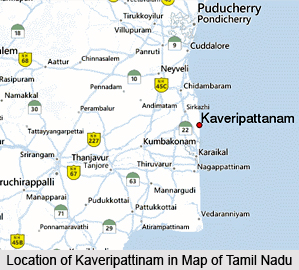 Kaveripattanam is a panchayat town situated in the Tamil Nadu state of India. Kaveripattinam is known by various names such as Puhar, Pumpuhar, Kaveripumpattinam, Pattinam and Cholapattinam. The Greaco-Roman writer Ptolemy (2nd century A.D.) refers to the place as `Khaberis Emporium`. Modernday foreign tourists have hailed it as the `Venice of the East`.
Kaveripattanam is a panchayat town situated in the Tamil Nadu state of India. Kaveripattinam is known by various names such as Puhar, Pumpuhar, Kaveripumpattinam, Pattinam and Cholapattinam. The Greaco-Roman writer Ptolemy (2nd century A.D.) refers to the place as `Khaberis Emporium`. Modernday foreign tourists have hailed it as the `Venice of the East`.
Location of Kaveripattinam
This picturesque archaeological site is located in Krishnagiri district of Tamil Nadu. Kaveripattinam is situated on the Coromandel Coast north of Tanjavur and south of Pondicherry. It is around 100 kilometres from Bangalore.
History of Kaveripattinam
The Siluppudikarum and the Pattinapalai, early Tamil poems, mainly provide a graphic description of the city, its mansions, temples, monasteries, bazaars and harbour. The excellent layout of the city, as described in these texts, would make the present day town planners envious. During the time of the Roman trade (300 B.C. to 300 A.D.), Kaveripattinam was the secondary capital and chief port of the Cholas, Uraiyur being their main capital.
Believed to have been covered with plates of shimmering gold, the Chola palace in the city is surrounded by a park, well stocked with game. But archaeologists have been unable to trace the location of this palace, till date. During those days, Kaveripattinam was an international trading station. The port had trade with Africa and the Roman Empire in the west and Sri Lanka and South East Asia in the east.
Attractions of Kaveripattinam
Archaeologists of recent times have been persistently trying to unearth portions of this ancient city lying buried under both the sea and the beach. An important discovery is the foundation of a large Buddhist monastery that flourished during the Roman times. The monastery consists of rows of cells or small rooms, built of bricks. The ruins are open to the public. Further down the same road, closer to the beach, is a one-room Archaeological Museum housing ceramics and other objects discovered in the area close to this, is another museum called the Kannagi Museum exhibiting the story of Kannagi, the heroine of the epic Silappadikamm which was written at Kaveripattinam during the days of the Roman trade. From the museums, one could walk up to the beach where the river Kaveri joins the Bay of Bengal.



















